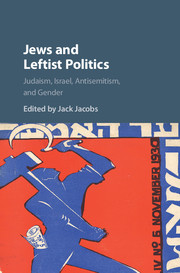Book contents
- Frontmatter
- Contents
- List of Contributors
- Acknowledgments
- Introduction
- PART ONE POLITICAL IMPLICATIONS OF JUDAISM
- PART TWO ANTISEMITISM AND THE LEFT
- PART THREE ISRAEL, ZIONISM, AND THE LEFT
- PART FOUR JEWS AND COMMUNISM
- PART FIVE GENDERED PERSPECTIVES
- 9 Gesia Gelfman: A Jewish Woman on the Left in Imperial Russia
- 10 Manya Shochat and Her Traveling Guns: Jewish Radical Women from Pogrom Self-Defense to the First Kibbutzim
- 11 The Gender of Jews and the Politics of Women: A Reflection
- PART SIX CANONICAL FIGURES
- PART SEVEN CASE STUDIES
- Glossary
- Index
10 - Manya Shochat and Her Traveling Guns: Jewish Radical Women from Pogrom Self-Defense to the First Kibbutzim
from PART FIVE - GENDERED PERSPECTIVES
Published online by Cambridge University Press: 13 April 2017
- Frontmatter
- Contents
- List of Contributors
- Acknowledgments
- Introduction
- PART ONE POLITICAL IMPLICATIONS OF JUDAISM
- PART TWO ANTISEMITISM AND THE LEFT
- PART THREE ISRAEL, ZIONISM, AND THE LEFT
- PART FOUR JEWS AND COMMUNISM
- PART FIVE GENDERED PERSPECTIVES
- 9 Gesia Gelfman: A Jewish Woman on the Left in Imperial Russia
- 10 Manya Shochat and Her Traveling Guns: Jewish Radical Women from Pogrom Self-Defense to the First Kibbutzim
- 11 The Gender of Jews and the Politics of Women: A Reflection
- PART SIX CANONICAL FIGURES
- PART SEVEN CASE STUDIES
- Glossary
- Index
Summary
THE VOLATILE JEWISH LEFT IN 1903
In the fall of 1903, Manya Wilbushevitz was twenty-five, active in a plan to assassinate the Russian minister of the interior, Vyachaslav von Plehve. She traveled to Berlin to raise funds for the project, living with her brother Gedaliah. While there, she learned that their plot had been uncovered and that certain arrest, perhaps a death sentence, awaited her comrades back in Russia. Gedaliah worried about her mental state and contacted their brother Nahum, who had moved to Palestine, imploring him to invite Manya to visit him there. Because she decided to remain in Palestine, she escaped the punishments meted out to her fellow conspirators. Manya was soon acquainted with the leading pioneers of the First Aliyah, who had departed Russia in the eighties and nineties. Four years later, she married another Russian radical, Israel Shochat. They raised two children in a stormy, complicated marriage. Manya kept up a hectic pace of activism over the years, purchasing and smuggling guns, transporting illegal immigrants, and advocating Arab equality. She imagined and founded an agricultural commune in 1907, which inspired the first kibbutzim. In this chapter we explore two junctures in Shochat's life. First we go back to the years between 1897 and 1903, when she was a firebrand activist with ties to several left parties. Then we jump forward to the fall of 1907, when her soon-to-be husband, Israel, helped to found Bar Giora, a secret military unit defending Jewish villages and farms.
Manya was certainly unusual in her edgy character, but she was simultaneously a recognizable type at the time. Her life illuminates how young women channeled the values of Russian radicalism into Zionism. That even a handful of female activists would use guns shows one of several ways that left movements helped women challenge traditional roles. Moreover, the politics of Manya Shochat and her friends, comrades, and enemies reverberated across the decades of twentieth-century history. The Russian Revolution of 1917, the so-called Judeo-Bolshevist synergy so hated by the Nazis, and the State of Israel founded in 1948 all have their roots in the complex tapestry of their passions and causes.
Manya was born to a large, wealthy, fascinating family and was endowed with a strong personality and remarkable stamina.
- Type
- Chapter
- Information
- Jews and Leftist PoliticsJudaism, Israel, Antisemitism, and Gender, pp. 200 - 216Publisher: Cambridge University PressPrint publication year: 2017

